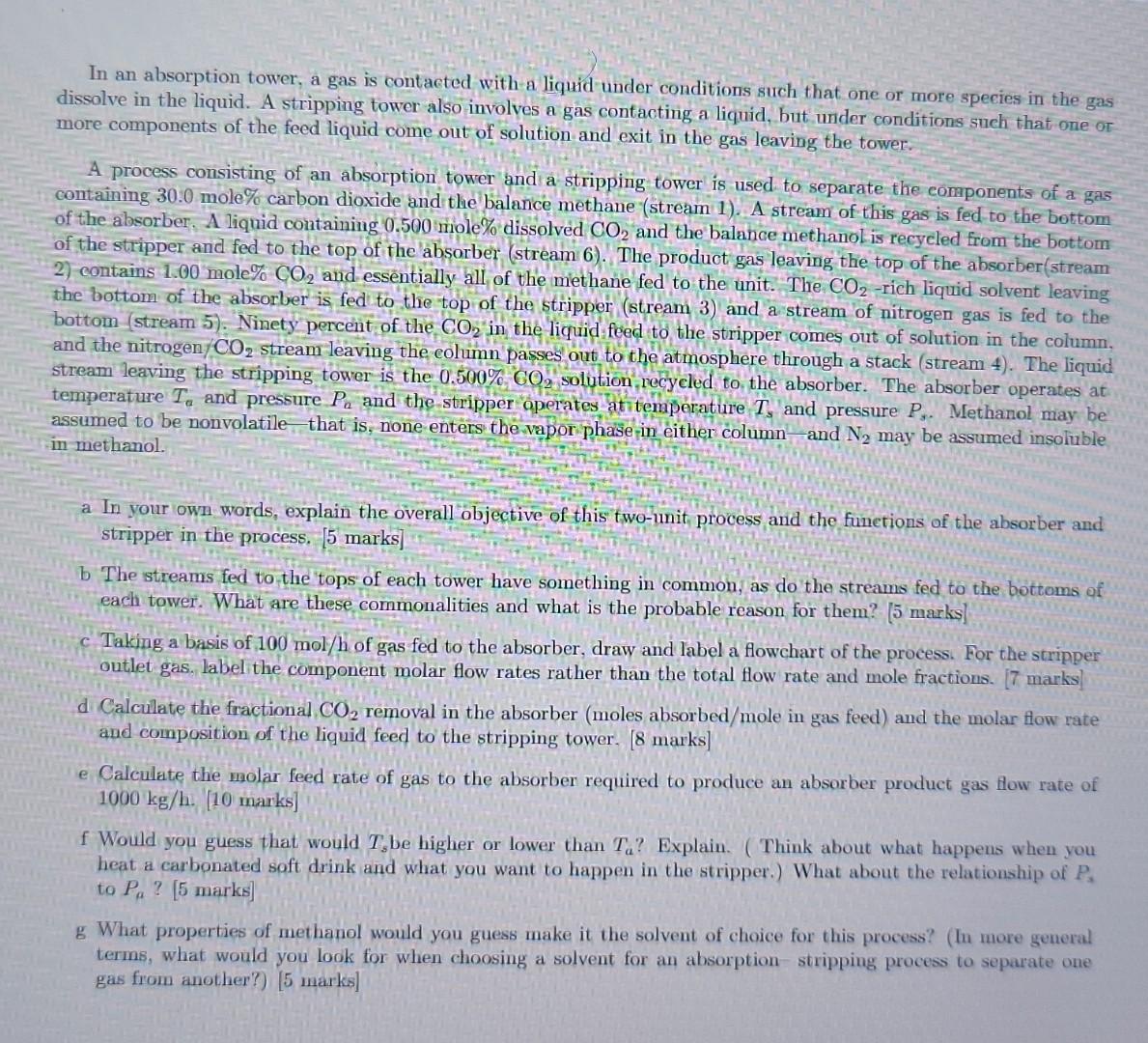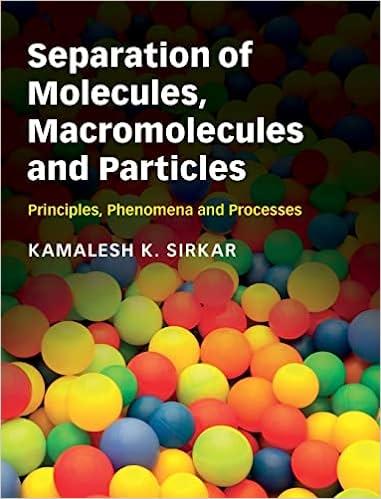Answered step by step
Verified Expert Solution
Question
1 Approved Answer
PROCESS ANALYSIS --> Please don't copy. Only solve if sure of the answer, don't waste my time, thank you! Problem 3, 50 marks Modified from


PROCESS ANALYSIS --> Please don't copy. Only solve if sure of the answer, don't waste my time, thank you!

Problem 3, 50 marks Modified from Problem 4-35 in Felder and Rousseau In an absorption tower, a gas is contacted with a liquid under conditions such that one or more species in the gas dissolve in the liquid. A stripping tower also involves a gas contacting a liquid, but under conditions such that one or more components of the feed liquid come out of solution and exit in the gas leaving the tower. A process consisting of an absorption tower and a stripping tower is used to separate the components of a gas containing 30.0 mole% carbon dioxide and the balance methane (stream 1). A stream of this gas is fed to the bottom of the absorber. A liquid containing 0.500 mole% dissolved CO2 and the balance methanol is recycled from the bottom of the stripper and fed to the top of the absorber (stream 6). The product gas leaving the top of the absorber(stream 2) contains 1.00 mole% CO2 and essentially all of the methane fed to the unit. The CO2 -rich liquid solvent leaving the bottom of the absorber is fed to the top of the stripper (stream 3) and a stream of nitrogen gas is fed to the bottom (stream 5). Ninety percent of the CO2 in the liquid feed to the stripper comes out of solution in the column. and the nitrogen CO2 stream leaving the column passes out to the atmosphere through a stack (stream 4). The liquid stream leaving the stripping tower is the 0.500% CO2 solution recycled to the absorber. The absorber operates at temperature T, and pressure P, and the stripper operates at temperature T, and pressure P, Methanol may be assumed to be nonvolatile that is, none enters the vapor phase in either column and N2 may be assumed insoluble in methanol. a In your own words, explain the overall objective of this two-unit process and the functions of the absorber and stripper in the process. [5 marks] b The streams fed to the tops of each tower have something in common, as do the streams fed to the bottoms of each tower. What are these commonalities and what is the probable reason for them? (5 marks Taking a basis of 100 mol/h of gas fed to the absorber, draw and label a flowchart of the process. For the stripper outlet gas, label the component molar flow rates rather than the total flow rate and mole fractions. 17 marks d Calculate the fractional CO2 removal in the absorber (moles absorbed/mole in gas feed) and the molar flow rate and composition of the liquid feed to the stripping tower. [8 marks] e Calculate the molar feed rate of gas to the absorber required to produce an absorber product gas flow rate of 1000 kg/h. [10 marks] f Would you guess that would T be higher or lower than T.? Explain. (Think about what happens when you heat a carbonated soft drink and what you want to happen in the stripper.) What about the relationship of P. to PA? (5 marks g What properties of methanol would you guess make it the solvent of choice for this process? (In more general terms, what would you look for when choosing a solvent for an absorption stripping process to separate one gas from another?) 15 marks] In an absorption tower, a gas is contacted with a liquid under conditions such that one or more species in the gas dissolve in the liquid. A stripping tower also involves a gas contacting a liquid, but under conditions such that one or more components of the feed liquid come out of solution and exit in the gas leaving the tower. A process consisting of an absorption tower and a stripping tower is used to separate the components of a gas containing 30.0 mole% carbon dioxide and the balance methane (stream 1). A stream of this gas is fed to the bottom of the absorber. A liquid containing 0.500 mole% dissolved CO, and the balance methanol is recycled from the bottom of the stripper and fed to the top of the absorber (stream 6). The product gas leaving the top of the absorber(stream 2) contains 1.00 mole% CO, and essentially all of the methane fed to the unit. The CO2 -rich liquid solvent leaving the bottom of the absorber is fed to the top of the stripper (stream 3) and a stream of nitrogen gas is fed to the bottom (stream 5). Ninety percent of the CO2 in the liquid feed to the stripper comes out of solution in the column and the nitrogen/CO2 stream leaving the column passes out to the atmosphere through a stack (stream 4). The liquid stream leaving the stripping tower is the 0.500% CO2 solution recycled to the absorber. The absorber operates at temperature T, and pressure P, and the stripper operates at temperature T, and pressure P. Methanol may be assumed to be nonvolatile that is, none enters the vapor phase in either column and N, may be assumed insoluble in methanol a In your own words, explain the overall objective of this two-unit process and the functions of the absorber and stripper in the process. 15 marks] b The streams fed to the tops of each tower have something in common, as do the streams fed to the bottoms of each tower. What are these commonalities and what is the probable reason for them? [5 marks] c Taking a basis of 100 mol/h of gas fed to the absorber, draw and label a flowchart of the process. For the stripper outlet gas, label the component molar flow rates rather than the total flow rate and mole fractions. [7 marks) d Calculate the fractional CO2 removal in the absorber (moles absorbed/mole in gas feed) and the molar flow rate and composition of the liquid feed to the stripping tower. [8 marks] e Calculate the molar feed rate of gas to the absorber required to produce an absorber product gas flow rate of 1000 kg/h. [10 marks] f Would you guess that would T be higher or lower than T.? Explain. (Think about what happens when you heat a carbonated soft drink and what you want to happen in the stripper.) What about the relationship of P. to Pa? [5 marks g What properties of methanol would you guess make it the solvent of choice for this process? (In more general terms, what would you look for when choosing a solvent for an absorption stripping process to separate one gas from another?) [5 marks]
Step by Step Solution
There are 3 Steps involved in it
Step: 1

Get Instant Access to Expert-Tailored Solutions
See step-by-step solutions with expert insights and AI powered tools for academic success
Step: 2

Step: 3

Ace Your Homework with AI
Get the answers you need in no time with our AI-driven, step-by-step assistance
Get Started


